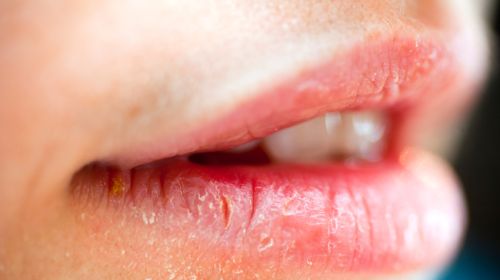Kidney stones are solid deposits of mineral salts that form in the kidneys. They can remain undetected for a long time – only when they migrate into the ureter and block the flow of urine do they cause severe, spasmodic pain. How are kidney stones treated?
- © Getty Images/supersizer
Brief overview: Kidney stones
Definition: Kidney stones are crystals in the urine that grow into stones in the kidneys. Possible consequences of a kidney stone are urinary stasis and urinary tract infections that damage the kidneys.
Causes: In most cases, a combination of certain metabolic diseases with insufficient fluid intake or malnutrition is responsible.
Symptoms: When the stones travel from the kidneys into the ureter, they cause severe, cramping pain called renal colic.
Diagnosis: The kidney stones are detected with an ultrasound or CT scan, and the causes of the stones are determined with laboratory tests of blood, urine and stones that have been removed.
Treatment: The first step is to wait and see whether the stones will come off on their own, possibly with the help of medication. If this is not the case, or if the stones are too large, they are shattered with shock waves or surgically removed.
Article content at a glance:
What are kidney stones?
Kidney stones (nephrolithiasis) are solid deposits that form from minerals or salts in the urine. Normally these substances are dissolved in the urine, but under certain circumstances they form crystals that can grow into stones. The generic term for stones in the kidneys or urinary tract is urinary stones (urolithiasis). Depending on where these urinary stones are located, specialists distinguish between them
- kidney stones (nephrolithiasis),
- Ureter stones (ureterolithiasis) and
- bladder stones (cystolithiasis).
In addition, kidney stones are differentiated based on their chemical composition: Calcium oxalate stones are the most common, otherwise uric acid stones and calcium phosphate stones are common.
Kidney stones can grow to enormous sizes: some are as big as a pinhead, others fill the entire kidney pelvis. Smaller stones are excreted unnoticed in the urine, larger ones can get stuck in the ureter and then cause great pain.
Urinary stones are one of the most common kidney diseases: In Germany, almost five percent of people are affected at least once, men more often than women. Anyone who has ever had urinary stones suffers a recurrence in 50 to 80 percent of cases.
Typical symptoms of kidney stones
Depending on the size and location of the kidney stones, a wide variety of symptoms can occur. As long as the stones are in the kidney tissue, they often do not cause any symptoms or are only noticeable by a slight pulling in the kidney area.
However, if the stones block the renal pelvis or travel through the ureter, severe, cramping pain in the lower abdomen or back occurs in waves. They are called renal colic and are often accompanied by nausea and vomiting. Renal colic can last between 20 and 60 minutes, during which time those affected usually have a strong urge to move. Small injuries to the mucous membrane in the urinary tract often lead to blood in the urine (hematuria). In addition, pain when urinating or a frequent urge to urinate are possible.
Kidney stones: causes and risk factors
Kidney stones form when the concentration of certain minerals or salts in the urine becomes so high that they crystallize and form stones. This happens especially when certain metabolic diseases are combined with insufficient fluid intake or malnutrition. The following risk factors increase the likelihood of stone formation:
- negative fluid balance due to not drinking enough or heavy sweating
- high meat consumption (or high-protein diet)
- overweight
- lack of exercise or bed confinement
- family history
- Metabolic disorders such as gout (gout, diabetes or cystinuria
- parathyroid disorders
- chronic inflammatory bowel disease (e.g. Crohn’s disease or ulcerative colitis)
- Urinary tract infections or anatomical changes in the kidneys or urinary tract
- Drugs that alter the urine
- Frequent consumption of foods containing oxalate
Diagnosis: This is how kidney stones are diagnosed
To diagnose kidney stones, a detailed discussion (anamnesis) is first conducted in the doctor’s office. The specific symptoms, medications taken, previous illnesses, drinking and eating habits and the presence of kidney stones in the family are asked about. This is followed by a physical examination in which the abdomen and kidney region are examined for tenderness.
If there is a suspicion of kidney stones, an ultrasound examination usually follows – most kidney stones can be detected with it. If this is not the case, a computer tomography (CT) is also carried out. At the same time, blood and urine tests are carried out in order to get to the bottom of the cause of the formation of the kidney stones. For example, if the uric acid level in the blood is too high, this can promote kidney stones. If a kidney stone can be secured after it has been passed, its chemical composition is checked to identify the excessive mineral salts.
Therapy: How are kidney stones treated?
With stones up to seven millimeters in diameter, you usually wait until they come off on their own. To support this process, at least 2.5 liters should be drunk per day, and exercise can also help. Appropriate medication can be prescribed for the pain. Muscle-relaxing medications (like alpha blockers) make it easier for the kidney stones to be cleared. In some cases, the kidney stones can also be dissolved with the help of medication (litholysis).
If kidney stones do not go away on their own after four weeks or if they are not suitable for medicinal dissolution, they must be removed. To do this, they are either shattered using shock waves or removed in an operation.
In shock wave therapy (extracorporeal shock wave lithotripsy, ESWL), a sonic probe is placed on the skin, which sends sound waves through the tissue to the kidney stones, breaking them up. After that, the debris goes out with the urine.
If the kidney stones are larger than two centimetres, they are surgically removed. Two different methods are used:
In ureterorenoscopy (URS), fine instruments are passed through the urethra and bladder to the stone in the ureter using an endoscope. There it is broken up mechanically or with a laser, the debris is removed directly or excreted in the urine.
Stones in the kidney are formed in a percutaneous nephrolithotripsy (PCNL): This involves inserting the endoscope into the kidney or renal pelvis through a small incision on the back. The stones are broken up mechanically or with a laser and removed or flushed out with small forceps.
Open surgeries are now very rare and necessary for very large kidney stones.
Course and prognosis of kidney stones
If left untreated, kidney stones can block the urinary tract, the backed-up urine can lead to infections and permanently damage the kidneys. However, this rarely happens because the kidney stones are usually painful beforehand and are treated accordingly.
In 50 to 80 percent of cases, there is a relapse within ten years. With preventive measures, however, the majority of patients can achieve freedom from symptoms.
Prevention: How can kidney stones be prevented?
If kidney stones are treated without doing anything about their cause, they are more likely to come back. What helps with prevention in individual cases depends on the cause of the kidney stones – that is why it is important to examine the composition of the kidney stones that have been passed or removed. Basically, it helps to drink a lot and change your diet. The following measures have proven themselves:
- Avoid soft drinks
- Avoiding foods containing oxalates (such as rhubarb, walnuts, spinach or chocolate)
- little animal protein
- low-salt diet
- low-purine diet (to avoid uric acid stones)
Most kidney stones contain calcium, however, avoiding the mineral does not protect against kidney stones and actually increases the risk of stone formation. Therefore, calcium should be consumed in sufficient amounts to prevent kidney stones.
In addition, weight loss and regular exercise can reduce the risk of developing kidney stones. If there is a high risk of kidney stone recurrence (e.g. a family history or certain pre-existing conditions), medication can also be used to prevent kidney stones. Which medications are suitable depends on the type of stones and is adjusted by the doctor.


